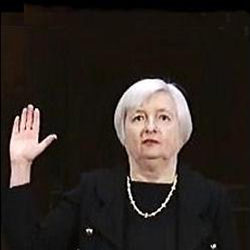By Pam Martens and Russ Martens: September 4, 2014
The Federal Reserve Board of Governors, together with the Federal Deposit Insurance Corporation and Office of the Comptroller of the Currency – the top regulators of Wall Street’s largest banks – finalized liquidity rules yesterday that make absolutely no sense to anyone with a historical perspective on how Wall Street operates in a crisis.
The Federal regulators adopted a new rule that requires the country’s largest banks – those with $250 billion or more in total assets – to hold an increased level of newly defined “high quality liquid assets” (HQLA) in order to meet a potential run on the bank during a credit crisis. In addition to U.S. Treasury securities and other instruments backed by the full faith and credit of the U.S. government (agency debt), the regulators have included some dubious instruments while shunning others with a higher safety profile.
Bizarrely, the Fed and its regulatory siblings included investment grade corporate bonds, the majority of which do not trade on an exchange, and more stunningly, stocks in the Russell 1000, as meeting the definition of high quality liquid assets, while excluding all municipal bonds – even general obligation municipal bonds from states with a far higher credit standing and safety profile than BBB-rated corporate bonds.
This, rightfully, has state treasurers in an uproar. The five largest Wall Street banks control the majority of deposits in the country. By disqualifying municipal bonds from the category of liquid assets, the biggest banks are likely to trim back their holdings in munis which could raise the cost or limit the ability for states, counties, cities and school districts to issue muni bonds to build schools, roads, bridges and other infrastructure needs. This is a particularly strange position for a Fed that is worried about subpar economic growth.
In the Fed’s rule statement for the Federal Register, it acknowledged public commenters’ challenges to its inexplicable bias against municipal bonds while embracing all things corporate, writing:
“…commenters asserted that the risk and liquidity profiles of municipal securities were comparable, if not superior, to the profiles of other types of assets the agencies proposed for inclusion as HQLA, such as corporate bonds, equities, certain foreign sovereign obligations, and certain securities of GSEs.
“A number of commenters expressed concerns that the proposed rule would have included certain sovereign securities for countries that have smaller GDPs than some U.S. states as HQLA while excluding obligations of U.S. states and local governments. Some of these commenters argued that the credit ratings of certain states compare favorably with those of countries whose obligations could be included as level 1 or level 2A liquid assets. Commenters also contended that municipal securities perform well and experience increased demand during times of stress. Several commenters asserted that banking organizations could liquidate large holdings of municipal securities with minimal market or price disruption during a crisis scenario.”
Making the Fed’s position even more untenable is the fact that the Basel III Revised Liquidity Framework, the global standard that the new rule seeks to address, does not envision gutting municipal bonds from the mix of suitable liquid assets.
The biggest hurdle for the Fed’s position is that municipal bonds are readily eligible for loans at the Fed’s discount window – trumping any argument that they could not command liquidity in a crisis.
The Fed’s rationale for including corporate bonds and stocks but not munis in the high quality liquid assets category rests on this premise:
“The agencies believe that defining an asset as liquid and readily-marketable if it is traded in an active secondary market with more than two committed market makers, a large number of committed non-market maker participants on both the buying and selling sides of transactions, timely and observable market prices, and high trading volumes provides an appropriate standard for determining whether an asset can be readily sold in times of stress.”
That premise lacks an historical foundation. In times of crisis, Wall Street veterans know full well that market makers have a nasty habit of backing away.
Anyone who attempted to find large volume liquidity in Nasdaq stocks during the 1987 crash would have been sorely disappointed. Relying on market makers to provide liquidity in the midst of a crisis event – the whole purpose of the Fed’s new rules – is relying on Tooth Fairy principles. Within the Fed’s own archives, we learn that on the day of the market crash in 1987:
“Market makers in the over-the-counter market were not obligated to maintain an orderly market and many withdrew from trading. Delays in processing trades resulted in investors receiving prices very different from what they expected. Many brokers did not answer their phones, leaving investors unable to reach them. Erratic price movements and quotes resulted in frequent lock-ups in the electronic trading system used in the over-the-counter market.”
That was all the way back in 1987 you may be thinking. But there was similar illiquidity in markets throughout the credit crisis in 2008 and 2009.
That the Fed and its regulatory cohorts have to resort to this implausible plan – which crimps the ability of states and localities to raise essential funds to operate – in a strained effort to pretend that they’ve found a means of avoiding another massive bailout of Wall Street in a crisis, is just further proof that the only way to seriously deal with too-big-to-fail banks is to restore the Glass-Steagall Act and break up these complex creatures before they strike again.


